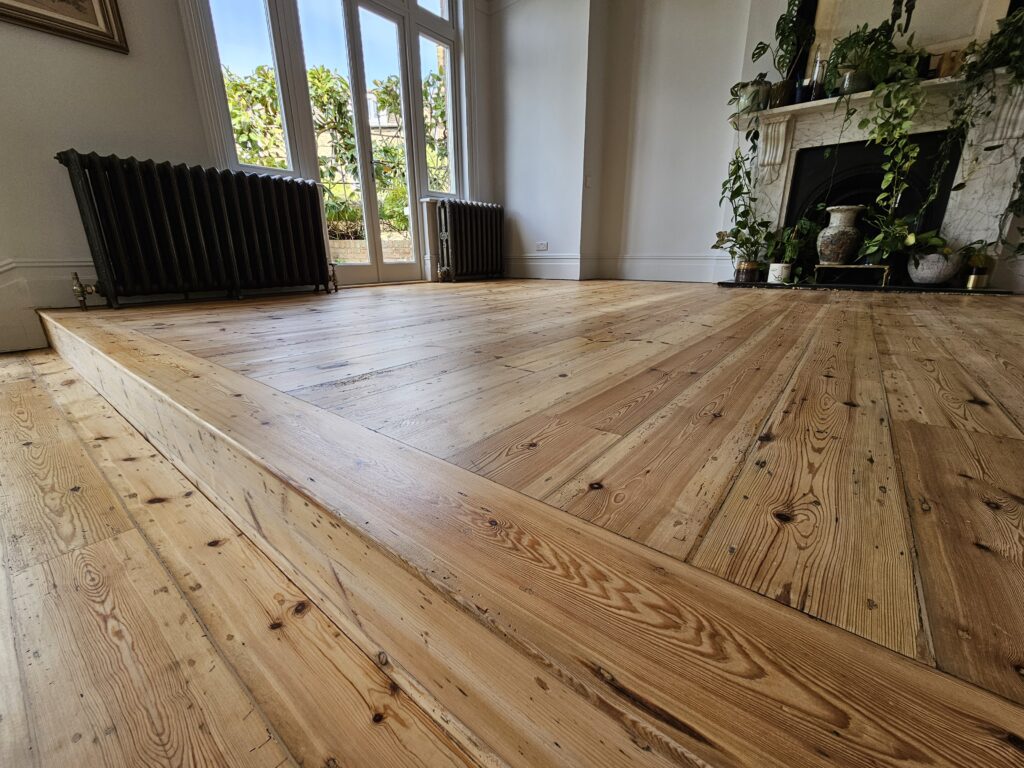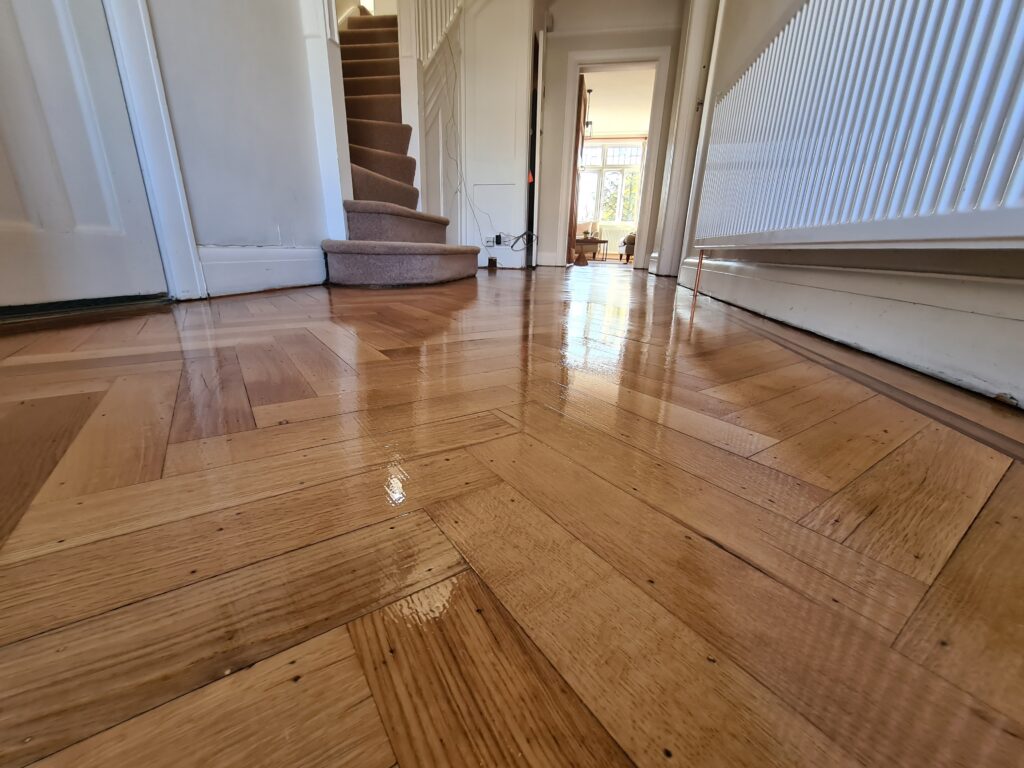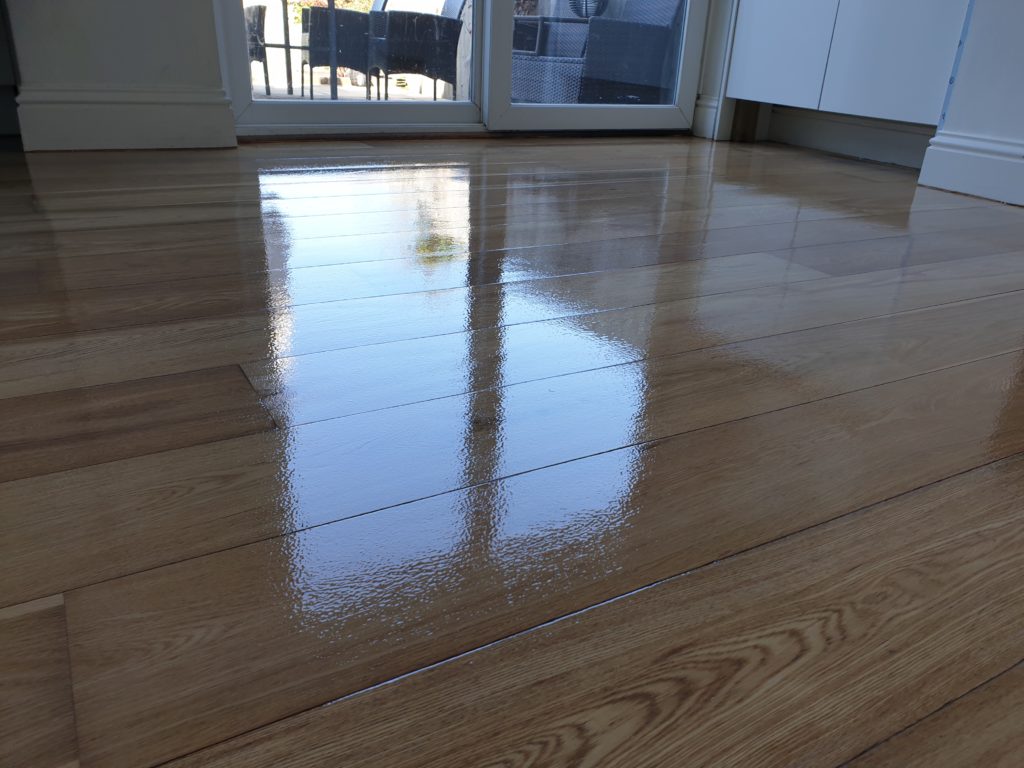Hardwood Restoration Tips:
The first tip I’d give is speed! When sanding with the big machine (Drum or Belt) never allow it to stop dead while the drum is in contact with the floor, even for a split second. This will certainly leave a deep gauge to the floor. This again goes back to the structures of the wood, which as we now know are closed. Meaning the machine requires less time in contact with the floor to remove its surface. The second, speed again! Once you have reached higher grades of abrasives, say 80-120 grit, it’s very important you move quickly to prevent burn marks appearing on the floor. Finally, do not over sand! Once an area of the floor is stripped clean back to bare wood and is free of any imperfections, move on to the next section. Going over and over the same piece is also a contributing factor to leaving burn marks. Not to mention removing way too much of the floor!
Historical Evolution
The history of hardwood flooring is steeped in tradition and craftsmanship, with roots tracing back to ancient civilizations where natural materials such as timber and hardwoods were meticulously fashioned into rudimentary floorboards. From the medieval period through the Renaissance, colonial expansion, and the industrial revolution, hardwood floors have evolved alongside architectural and design movements, reflecting cultural influences, regional craftsmanship, and technological advancements.
Design Inspirations
Hardwood flooring serves as a blank canvas for limitless design possibilities, seamlessly blending with a spectrum of design styles, from classic and traditional to modern and contemporary. Whether it is the warm, rustic charm of wide-plank oak floors or the intricate beauty of parquet patterns, hardwood flooring embodies an elegance that transcends trends, inviting personal expression and creating a lasting visual impact in any space.
Trends and Innovations
While hardwood flooring exudes timeless elegance, it also continues to evolve with the introduction of innovative materials, finishes, and installation techniques. We delve into the latest trends in hardwood flooring, from the resurgence of wide-plank flooring to the growing demand for sustainable and eco-friendly options. Additionally, we explore the advancements in engineered hardwood, showcasing its versatility and resilience in various environments.
Celebrating Craftsmanship
At the heart of hardwood flooring lies the artistry and craftsmanship of skilled professionals who bring out the intrinsic beauty of natural wood. Our blog pays homage to the dedicated artisans and craftsmen who meticulously create, install, and finish hardwood floors, elevating them from mere functional elements to timeless works of art that evoke warmth, character, and sophistication.
Maintenance and Care
Preserving the timeless allure of hardwood flooring requires proper maintenance and care. Our blog provides practical tips for cleaning, maintaining, and protecting hardwood floors, emphasizing the importance of regular upkeep to ensure longevity and enduring beauty. From choosing the right cleaning products to addressing minor imperfections, we offer valuable insights to empower homeowners to safeguard and cherish their hardwood floors for generations to come.
Maintenance and regular cleaning are crucial for preserving the timeless allure and longevity of hardwood floors. Here are some valuable tips for maintaining and cleaning hardwood floors:
1. Regular Cleaning Routine:
– Sweep or vacuum the hardwood floors regularly to remove dust, dirt, and debris, which can cause scratches and wear.
– Use a vacuum with a floor-brush attachment or a soft-bristle broom to prevent scratching the floor surface.
2. Damp Mopping Technique:
– For a deeper clean, use a well-wrung damp mop with a hardwood floor cleaner specifically designed for your floor’s finish. Avoid using excessive water, as standing moisture can damage the wood.
3. Spills and Stains:
– Wipe up spills immediately using a soft, clean cloth to prevent moisture from seeping into the wood and causing damage or stains.
– For tough stains, use a recommended hardwood floor cleaner or a solution of mild soap and water, applying it sparingly and blotting the area dry promptly.
4. Avoid Harsh Chemicals:
– Refrain from using harsh cleaning agents, ammonia-based cleaners, or abrasive cleansers, as they can dull the floor’s finish and damage the wood over time.
5. Protecting the Finish:
– Use furniture pads or protective mats under heavy furniture and high-traffic areas to minimize scratches and wear on the floor’s finish.
– Place doormats at entryways to trap dirt and prevent outdoor debris from being tracked onto the hardwood floors.
6. Regular Maintenance:
– Periodically assess the condition of the floor and address any scratches, dents, or worn areas promptly to prevent further damage.
– Consider using a recommended hardwood floor polish or rejuvenator to refresh the floor’s finish as needed, following the manufacturer’s guidelines.
7. Humidity Control:
– Maintain a consistent humidity level in the home, as excessive moisture or dryness can impact the stability of hardwood floors. Use a humidifier during dry seasons and air conditioning or a dehumidifier in humid conditions.
8. Professional Care:
– Schedule professional maintenance, such as sanding and refinishing, when the floor’s finish shows signs of significant wear, scratches, or dullness.
By incorporating these maintenance and cleaning tips into your routine, you can ensure that your hardwood floors retain their timeless elegance and natural beauty for years to come. Additionally, following the manufacturer’s recommendations and seeking professional advice when necessary can help you maintain the integrity of your hardwood flooring investment.





